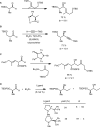Overriding Felkin control: a general method for highly diastereoselective chelation-controlled additions to alpha-silyloxy aldehydes
- PMID: 20218659
- PMCID: PMC2850917
- DOI: 10.1021/ja910717p
Overriding Felkin control: a general method for highly diastereoselective chelation-controlled additions to alpha-silyloxy aldehydes
Abstract
According to the Felkin-Anh and Cram-chelation models, nucleophilic additions to alpha-silyloxy aldehydes proceed through a nonchelation pathway due to the steric and electronic properties of the silyl group, giving rise to Felkin addition products. Herein we describe a general method to promote chelation-control in additions to alpha-silyloxy aldehydes. Dialkylzincs, functionalized dialkylzincs, and (E)-disubstituted, (E)-trisubstituted, and (Z)-disubstituted vinylzinc reagents add to silyl-protected alpha-hydroxy aldehydes with high selectivity for chelation-controlled products (dr of 10:1 to >20:1) in the presence of alkylzinc halides or triflates, RZnX. With the high functional group tolerance of organozinc reagents, the mild Lewis acidity of RZnX, and the excellent diastereoselectivities favoring the chelation-controlled products, this method will be useful in the synthesis of natural products. A mechanism involving chelation is supported by (1) NMR studies of a model substrate, (2) a dramatic increase in reaction rate in the presence of an alkylzinc halide, and (3) higher diastereoselectivity with larger alkyl substituents on the alpha-carbon of the aldehyde. This method provides access to chelation-controlled addition products with high diastereoselectivity previously unavailable using achiral organometallic reagents.
Figures






Similar articles
-
Diastereoselective chelation-controlled additions to β-silyloxy aldehydes.Org Lett. 2012 Jul 6;14(13):3368-71. doi: 10.1021/ol301354w. Epub 2012 Jun 21. Org Lett. 2012. PMID: 22721430 Free PMC article.
-
Highly diastereoselective chelation-controlled additions to α-silyloxy ketones.J Am Chem Soc. 2011 May 25;133(20):7969-76. doi: 10.1021/ja201629d. Epub 2011 May 2. J Am Chem Soc. 2011. PMID: 21534530 Free PMC article.
-
Reactions of Allylmagnesium Reagents with Carbonyl Compounds and Compounds with C═N Double Bonds: Their Diastereoselectivities Generally Cannot Be Analyzed Using the Felkin-Anh and Chelation-Control Models.Chem Rev. 2020 Feb 12;120(3):1513-1619. doi: 10.1021/acs.chemrev.9b00414. Epub 2020 Jan 6. Chem Rev. 2020. PMID: 31904936 Free PMC article. Review.
-
Chelation-Controlled Additions to Chiral α- and β-Silyloxy, α-Halo, and β-Vinyl Carbonyl Compounds.Acc Chem Res. 2017 Sep 19;50(9):2389-2400. doi: 10.1021/acs.accounts.7b00319. Epub 2017 Aug 15. Acc Chem Res. 2017. PMID: 28809470
-
Asymmetric functional organozinc additions to aldehydes catalyzed by 1,1'-bi-2-naphthols (BINOLs).Acc Chem Res. 2014 May 20;47(5):1523-35. doi: 10.1021/ar500020k. Epub 2014 Apr 16. Acc Chem Res. 2014. PMID: 24738985 Free PMC article. Review.
Cited by
-
Diastereoselective chelation-controlled additions to β-silyloxy aldehydes.Org Lett. 2012 Jul 6;14(13):3368-71. doi: 10.1021/ol301354w. Epub 2012 Jun 21. Org Lett. 2012. PMID: 22721430 Free PMC article.
-
Highly diastereoselective chelation-controlled additions to α-silyloxy ketones.J Am Chem Soc. 2011 May 25;133(20):7969-76. doi: 10.1021/ja201629d. Epub 2011 May 2. J Am Chem Soc. 2011. PMID: 21534530 Free PMC article.
-
Reactions of Allylmagnesium Reagents with Carbonyl Compounds and Compounds with C═N Double Bonds: Their Diastereoselectivities Generally Cannot Be Analyzed Using the Felkin-Anh and Chelation-Control Models.Chem Rev. 2020 Feb 12;120(3):1513-1619. doi: 10.1021/acs.chemrev.9b00414. Epub 2020 Jan 6. Chem Rev. 2020. PMID: 31904936 Free PMC article. Review.
-
Alkenes as Chelating Groups in Diastereoselective Additions of Organometallics to Ketones.Organometallics. 2014 Oct 13;33(19):5371-5377. doi: 10.1021/om5007006. Epub 2014 Sep 9. Organometallics. 2014. PMID: 25328269 Free PMC article.
-
Enantioselective synthesis of anti-3-alkenyl-2-amido-3-hydroxy esters: application to the total synthesis of (+)-alexine.RSC Adv. 2019 Jan 21;9(5):2799-2802. doi: 10.1039/c9ra00173e. eCollection 2019 Jan 18. RSC Adv. 2019. PMID: 35520501 Free PMC article.
References
-
- Corey EJ, Cheng X-M. The Logic of Chemical Synthesis. Wiley; New York: 1989.
-
- Nicolaou KC, Snyder SA. Classics in Total Synthesis II : More Targets, Strategies, Methods. Wiley-VCH; Weinheim, Germany: 2003.
-
- Nicolaou KC, Sorensen EJ. Classics in Total Synthesis. VCH; Weinheim, Germany: 1996.
-
- Koskinen A. Asymmetric Synthesis of Natural Products. Wiley; Chichester, NY: 1993.
-
- Guillarme S, Ple K, Banchet A, Liard A, Haudrechy A. Chem. Rev. 2006;106:2355–2403. - PubMed
Publication types
MeSH terms
Substances
Grants and funding
LinkOut - more resources
Full Text Sources

